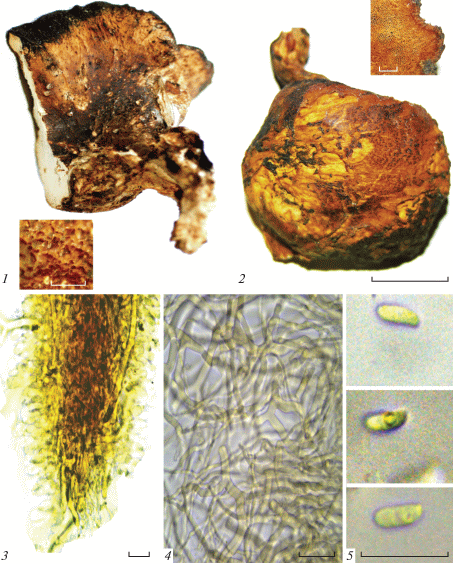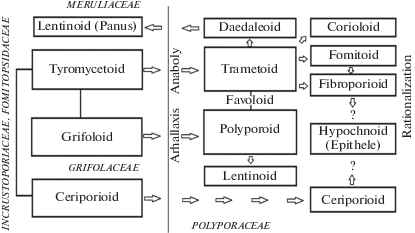Микология и фитопатология, 2019, T. 53, № 5, стр. 319-322
A stipe reduction series in Lentinus substrictus (= Polyporus ciliatus) (Polyporaceae, Agaricomycetes)
I. V. Zmitrovich 1, *, V. A. Vlasenko 2, **, I. V. Stavishenko 3, ***, A. V. Vlasenko 2, ****
1 Komarov Botanical Institute of the Russian Academy of Sciences
197376 St. Petersburg, Russia
2 Central Siberian Botanical Garden of the Siberian Branch of the Russian Academy of Sciences
630090 Novosibirsk, Russia
3 Institute of Plant and Animal Ecology of the Ural Branch of the Russian Academy of Sciences
620144 Ekaterinburg, Russia
* E-mail: iv_zmitrovich@mail.ru
** E-mail: vlasenkomyces@mail.ru
*** E-mail: stavishenko@bk.ru
**** E-mail: anastasiamix81@mail.ru
Поступила в редакцию 19.05.2018
После доработки 10.11.2018
Принята к публикации 12.12.2018
Аннотация
The theme of morphoses in agaricomycetes seems to be an important issue for two reasons. The first one, our knowledge on marginal and deviant forms sufficiently extends our understanding of intraspecific polymorphism, which makes the diagnostics procedure to be more accurate. The second one, the description of little-known ecotypes have a certain theoretical value, since highlighting ecological mechanisms of species divergence. The polyporoid fungus Lentinus substrictus, widely known also as Polyporus ciliatus, normally is characterized by polyporoid morphotype, i.e. basidiome differentiated into annual pileus with poroid hymenophore and more or less central stipe rooted in the wood substrate. However, the stipe can be eccentric or lateral, some specimens can appear a trametoid morphotype with subdorsal attachment. The purpose of the present communication is a description of such deviant form. A new form, Lentinus substrictus forma subtrametoideus was described basing on the Urals and Siberian material and its exhaustive characteristics was given. Some notes on polypores morphogeny were made.
The theme of morphoses in agaricomycetes, raised in our previous report (Vlasenko et al., 2017), seems to be an important issue for two reasons. The first one, our knowledge on marginal and deviant forms sufficiently extends our understanding of intraspecific polymorphism, which makes the diagnostics procedure to be more accurate. The second one, the description of little-known ecotypes have a certain theoretical value, since highlighting ecological mechanisms of species divergence (Zmitrovich, 2017).
The polyporoid fungus Lentinus substrictus (Bolton) Zmitr. et Kovalenko, widely known also as Polyporus ciliatus Fr., was described by Bolton (1792) as Boletus substrictus Bolton and was considered within Polyporus genus for a long time (Fries, 1815, 1821; Ryvarden, Melo, 2014). Beginning with Krüger and Gargas (2004), a congeneric nature of Lentinus s. str. with some representatives of “large Polyporus”, as Polyporus arcularius, P. brumalis, P. tricholoma, etc. becomes obvious and a new combination, Lentinus substrictus (Zmitrovich, Kovalenko, 2016) was made to avoiding a homonym Lentinus ciliatus Lév.
Normally, this species is characterized by polyporoid morphotype, i.e. basidiome differentiated into annual pileus with poroid hymenophore and more or less central stipe rooted in the wood substrate. However, the stipe can be eccentric or lateral, some specimens can appear a trametoid morphotype with subdorsal attachment. The purpose of the present communication is a description of such deviant forms.
Species morphological analysis was carried out as it was described in our previous report (Vlasenko et al., 2017). Herbarium material of Komarov Botanical Institute RAS (LE), Saint Petersburg, Central Siberian Botanical Garden SB RAS (NSK), Novosibirsk, and Institute of Plant et Animal Ecology (SVER), Ekaterinburg was used. Stereomicroscope Carl Zeiss Stemi DV4 and light microscope Micmed-6 were used to the species identification. Detailed study of the anatomical and morphological features was performed on a light microscope Carl Zeiss Axioskop-40 and stereo microscope Carl Zeiss Stereo Discovery V 12. Photomicrographs were obtained with a microscope Leica DM1000 LED with color digital camera Leica DFC 295 (Leica Microsystems, Germany) and software for image analysis ImageScope M (Russia; http://www.microscop.ru).
L. substrictus (Bolton) Zmitr. et Kovalenko, 2016, Int. J. Medicinal Mushrooms 18(1): 35; ≡ Boletus substrictus Bolton, Hist. fung. Halifax, App. 3: 170, 1792; = P. ciliatus Fr., Observ. mycol. 1: 123, 1815; = P. guarapiensis Speg., Anal. Soc. cient. argent. 26(1): 6, 1888; = P. saitoi Lloyd, Mycol. Writ. 7: 1269, 1924; = P. ustalis Velen., České Houby 4–5: 671, 1922; = P. zonatus Velen., České Houby 4–5: 671, 1922.
Basidiomes annual, of polyporoid, rarely subtrametoid habit, usually centrally stipitate, in extremal cases subpendent, solitary, rarely joint in small clusters. Pileus circular to semicircular of fan-shaped, up to 10 cm in diam. and 10 mm thick at the base. Upperside hazel to clay-brown, then chestnut or umber-brown, matt, irregularly squamulose or cracked with formation of clay-yellow pattern, azonate. Margin even or lobate, usually incurved, ciliate or not. Hymenophore as a single tube layer 1–7 mm thick, slightly decurrent on the stipe; pore surface ivory to tan or ochraceous, pores circular, then angular, 5–8 (9) per mm. Context initially touhg-fleshy, then suberous, white to ivory-white, 2–5 mm thick. Stipe usually central, rarely eccentric or absent, up to 8 cm long and 8 mm thick, hazel or cinnamon, with a fine tomentum that disappears with age.
Hyphal system dimitic. Generative hyphae 2–4(10) μm in diam., thin-walled, hyaline, with clamps, weakly amyloid in the stipe, dichotomously branched. Skeleto-binding hyphae 3–4 (12) in diam., thick-walled, with inflated body and subsolid appendages, hyaline to golden-brown. Leptocystidia fusoid, 10–25 × 4–5 μm. Basidia 15–27 × 4–6.5 μm, clavate, 4-spored, with a basal clamp. Basidiospores 5.1–8.5 × 2–2.3 μm, cylindrical, flattened at ventral side, in some projections slightly curved, hyaline, thin-walled, inamyloid, acyanophilous.
On dead wood (twigs, trunks, stumps, hollows, debris) of frondose (Acer, Aesculus, Alnus, Betula, Corylus, Cornus, Crataegus, Eucalyptus, Fagus, Fraxinus, Ilex, Malus, Padus, Populus, Prunus, Pyrus, Rhamnus, Robinia, Quercus, Salix, Sorbus, Tilia, Ulmus), rarely coniferous (Abies, Picea, Pinus) trees in Holarctic and South America. Causes a white rot (Ryvarden, Melo, 2014).
Lentinus substrictus forma subtrametoideus Zmitr., Vlasenko et Stavishenko f. nov. (MB 824134). – Fig. 1.
Fig. 1.
Lentinus substrictus f. subtrametoideus: 1 – Holotype (upperside and hymenophore), 2–5 – Paratype (2 – upperside and hymenophore, 3 – hyphal texture of tube dissepiment, 4 – skeleto-binding hyphae, 5 – basidiospores). Scale bars – 1 cm (1, 2), 10 µm (3–5). On the sidebars – 1 mm (1, 2).

From a neutral morphotype differs by reduced strongly eccenric (to absent) stipe.
The material includes two specimens, one has a strongly eccentric stipe, whereas the second is devoid of stipe and has a subdorsal attachment. Both basidiomes of subtrametoid habit, pilei 3–6 cm in longest dimension, up to 1 cm thick at the base. Upperside matt, azonate, clay-buff to chestnut at the base, furnished by irregular dots and squamules stripes, the chestnut areas are cracked with exposure of clay-yellow subpellis. Margin rather thick, slightly lobate, without cilia. Hymenophore as a single tube layer, 0.5–3 mm thick, pore surface pale to ochraceous, pores angular, 7–9 per mm. Context thick, up to 0.9 cm at the base, suberous, ivory-white, Stipe strongly reduced to absent, up to 1 cm long and 0.5 cm thick, cinnamon, with collapsed tomentum.
Hyphal system dimitic. Generative hyphae 2.5–3.5 (7.5) μm in diam., thin-walled, hyaline, with clamps, weakly amyloid in the stipe area, dichotomously branched. Skeleto-binding hyphae 3–4.5 (11.5) in diam., thick-walled, with inflated body and subsolid appendages, hyaline to golden-brown. Leptocystidia fusoid, 12–20 × 4–5 μm. Basidia 17–25 × 4–6 μm, clavate, 4-spored, with a basal clamp. Basidiospores 5.1–8.3 × 2–2.2 μm, cylindrical, ventrally flattened, hyaline, thin-walled, inamyloid, acyanophilous.
Holotype (designated here): Russia, Novosibirsk Region, park of Academician city, on hollow of Padus avium trunk, 25.01.2015, V.A. Vlasenko and A.V. Vlasenko (LE 286751).
Isotype (designated here): Russia, Novosibirsk Region, park of Academician city, on hollow of P. avium trunk, 25.01.2015, V.A. Vlasenko and A.V. Vlasenko (NSK 1013113).
Paratype (designated here): Russia, Sverdlovsk Region, Visim State Reserve, on fallen log of Betula sp., 21.06.2004, I.V. Stavishenko (LE 287653).
The form described fills a morphological gap between polyporoid and trametoid morphotypes. As it turns out, the process of stipe reduction can be realized quite easy in polyporoid fungi, although so far there are not many taxa of the polyporoid-subtrametoid appearance. Among them we note such taxa as Neofavolus alveolaris (DC.) Sotome et T. Hatt., Favolus grammocephalus (Berk.) Imazeki, F. pseudobetulinus (Murashk. ex Pilát) Sotome et T. Hatt., Cerioporus choseniae (Vassilkov) Zmitr. et Kovalenko. Within the genus Lentinus s.str. the stipe reduction has not been noted so far, although Kreisel (1960, 1963) noted that a central stem in some representatives of the Polyporus arcularius-complex can vary in length.
Thus, the polyporoid and trametoid morphotypes are linked by transitional favoloid one and as a whole are morphogenetically plastic, easily allowing the processes of morphological rationalization (Fig. 2).
The hollows where the most of the morphoses of polyporaceous fungi are realized represent rather specific niche, which occupation may be associated with certain speciation processes (an establishment of a new mode of polymorphism). Therefore, all the reports on deviant forms represent an interest for new exploratory studies.
The work by I.V. Zmitrovich was carried out within the framework of the State Task N АААА-А19-119020890079-6 of Komarov Botanical Institute of the Russian Academy of Sciences. The work by V.A. Vlasenko and A.V. Vlasenko was carried out within the framework of the State Task of Central Siberian Botanical Garden of Siberian Branch of the Russian Academy of Sciences, АААА-А17-117012610055-3. The work by I.V. Stavishenko was carried out within the framework of the State Task of Institute of Plant et Animal Ecology of Ural branch of the Russian Academy of Sciences, N 01201356806. NSK, SVER and LE herbarium specimens were used.
Список литературы
Bolton J. An history of fungusses, growing about Halifax. Vol. 3. Appendix. London, 1792.
Fries E. Observationes mycologicae praecipue ad illustrandam Floram Svecicam. Pt. I. Bonnier, Havn, 1815.
Fries E. Systema mycologicum, sistens fungorum ordines, genera et species, huc usque cognitas, quas ad normam methodi naturalis determinavit, disposuii atque descripsit. Vol. 1. Gryphiswald, 1821.
Kreisel H. Die Systematische Stellung der Gattung Polyporus. Zeitschr. Pilzk. 1960. V. 26 (2/3). P. 44–47.
Kreisel H. Über Polyporus brumalis und verwandte Arten. Fedd. Repert. 1963. V. 68. P. 129–138.
Krüger D., Gargas A. The basidiomycete genus Polyporus – an emendation based on phylogeny and putative secondary structure of ribosomal RNA molecules. Fedd. Repert. 2004. V. 115. P. 530–546.
Ryvarden L., Melo I. Poroid fungi of Europe / with photos by T. Niemelä and drawings by I. Melo and T. Niemelä. Synopsis Fungorum. 2014. V. 31. P. 1–455.
Vlasenko V.A., Vlasenko A.V., Zmitrovich I.V. First record of Neolentinus lepideus f. ceratoides (Gloeophyllales, Basi-diomycota) in Novosibirsk Region. Current Res. Envir. Appl. Mycol. 2017. V. 7 (3). P. 187–192.
Zmitrovich I.V. Phylogenesis and agaptatiogenesis of polyporaceous fungi (family Polyporaceae s.str.). Dr. Sci. Thesis. Saint Petersburg, 2017 (in Russ.).
Zmitrovich I.V., Kovalenko A.E. Lentinoid and polyporoid fungi, two generic conglomerates containing important medicinal mushrooms in molecular perspective. Int. J. Medicinal Mushrooms 2016. V. 18 (1). P. 23–38.
Змитрович И.В. (Zmitrovich) Филогенез и адаптациогенез полипоровых грибов (семейство Polyporaceae s. str.). Дисс. … докт. биол. наук. СПб.: БИН РАН, 2017. 364 с.
Дополнительные материалы отсутствуют.
Инструменты
Микология и фитопатология



